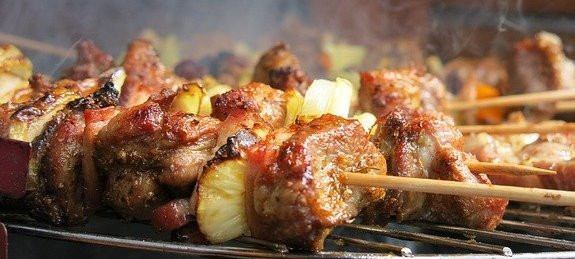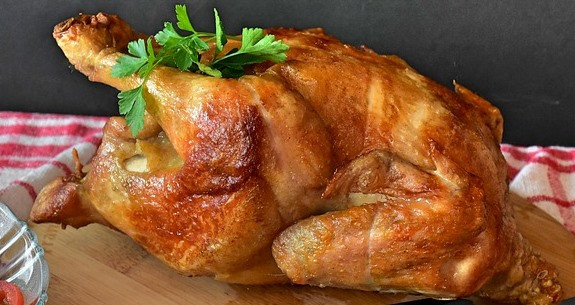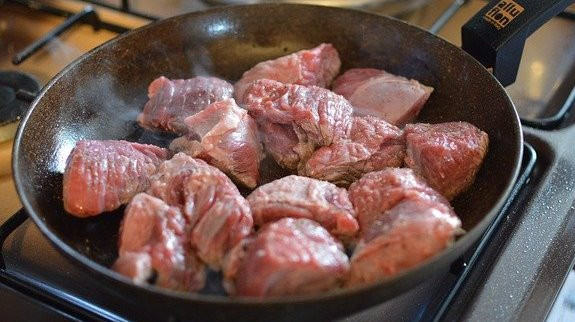Dry cooking methods
There are four main dry cooking methods: baking, grilling, roasting and dry frying.
Baking
Baking uses dry heat to cook our food, usually in an oven. Many foods can be baked in the oven: bread, cakes, pies, pastries and tarts. Whole fish such as salmon and sea bass can also be baked. Baked potatoes are also a popular meal option. Meat can also be baked in casseroles although large pieces of meat are usually roasted.

Hot air rises in the oven, so the top is often much hotter than the bottom. This means that food will cook quicker on the top shelf than on the bottom shelf. Most electric ovens are usually fan assisted or even convection ovens. They have a fan inside that helps to circulate the hot air around the oven. Fan assisted ovens are useful as they help food bake more evenly, as the oven is at a consistent temperature. As the oven heats up and cooks quicker less energy is also used.
Heat is transferred around the oven by radiation and convection and through the food by conduction.
The advantages and disadvantages of baking
Advantages
A very wide variety of food can be baked in an oven.
The outside of the food will brown and crisp up, which makes it look and taste nice.
As no extra fat is used in the cooking process it can be a healthier way to cook.
Disadvantages
Baking food can take a long time.
If over baked, food will dry out.
Baking requires a lot of energy as the oven has to be kept at high temperatures for a long time.
Grilling
Grilling uses a dry heat at a higher temperature than baking or roasting to cook food. As food is grilled the fat drips out of the food and the outside of the food becomes golden and crisp.
Barbecuing is similar to grilling, but the heat radiates from hot coals and the food is cooked at lower temperatures for longer.

Many foods can be grilled, including meats (steaks and burgers), vegetables (aubergines and courgettes) and cheeses (halloumi).
Heat is transferred to the food by radiation when grilling, or by conduction if using a griddle pan.
The advantages and disadvantages of grilling
Advantages
The food cooks quickly at high temperatures.
It’s fairly healthy as no fat is added and fat drips off when cooking.
As with baking and roasting the food is golden on the outside and crispy making it looks and taste nice.
Barbecuing gives food a smoky flavour.
Disadvantages
A high heat can make it difficult to cook food evenly.
The food can be burned easily if you are not careful.
You can cross contaminate on a barbecue as you handle raw and cooked meat.
Roasting
Like in baking roasting uses the dry heat of an oven. Roasting is done at a higher temperature than baking, so foods cook and brown more quickly.
You often add fat to the outside of food to keep it moist and help it brown (e.g. potatoes or parsnips). You can add fat that has melted from the food (e.g. chicken) this is called basting.
Large cuts of meat (leg of lamb, a cut of beef, or a whole chicken) are the most common foods to roast, as well as vegetables, peppers and onions.

Heat is transferred around the oven by radiation and convection and through the food by conduction.
The advantages and disadvantages of roasting
Advantages
Extra fat and high temperate helps to brown and crisp the outside of the food, which make it look good and taste delicious.
The fat left behind from roasted meat can be used to cook other food such as potatoes.
Roasted food can be tasty and moist.
Disadvantages
Extra fat is added so roasting isn’t the healthiest option.
Roasting like baking takes a long time so uses lots of energy.
Dry Frying
Dry frying is simply frying food without adding fat or oil. It is used for foods that contain fats such as minced meat or bacon. As the food heats up the fats in the foods melt out into the pan and begin to cook the food.

You need to use a medium heat at the start to allow the fat to melt out. This will stop the food from burning. As the fats melt out the temperature can be increased.
When dry frying, heat is transferred by conduction.
The advantages and disadvantages of dry frying
Advantages
It is a healthier cooking method as no fat is added.
Drying roasting can be used to give a distinct aroma to nuts, seeds and spices.
Disadvantages
It takes longer to cook than frying as you need to start with lower temperatures to avoid burning.
Only a limited number of foods can be dry fried.
